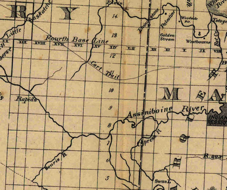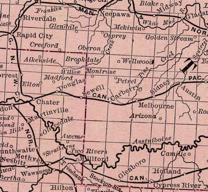THE THOUSANDS OF PEOPLE who
have made Carberry and area their home, since its inception in 1882,
have been a fascinating group, full of strength and wisdom, wit and
vigour, kindness and foresight.
Some of these people are also significant, key figures in our history.
They have either come to define the region by their very being, or they
have changed our communities through their actions and decisions.
This booklet recognizes and honours these people.
On the following pages you will encounter the collection of people who
have made a real difference. We have chosen to explore and describe
these people through a focus on traditional occupations and
avocations. With one key person typically defining each entry (a
merchant, a school teacher, a brick-maker, etc.) we expect that the
rich and deep experience of life and work in Carberry can be
effectively and succinctly defined. In doing so, by necessity, we have
of course left out many who also contributed.
The people profiled in this booklet are special, but we have also
endeavoured to feature others with slightly lesser claims to
significance who help define or enhance a certain entry. And where
possible we have also added information and details on certain
occupations and avocations so that readers can come to fully understand
and appreciate who these people were, what they did, and how they did
it.
This booklet was developed through a project called Notable People, an
initiative of the Historic Resources Branch of Manitoba Culture,
Heritage and Tourism. That project allowed us to develop a
comprehensive inventory of potential candidates, and to carefully
analyze and assess the relative significance of the 140 individuals
profiled. We are grateful to the Province for this support and
direction.
It is easy at the turn of the 21st century to forget the origins and
qualities of Manitoba’s smaller communities. But at their beginnings
these were very industrious places, with young, ambitious people, full
of life, and with great dreams for their new home. It is also important
to recall that these places were also self-sustaining, with nearly
everything one would need made at hand. Much of what was required for
daily life was manufactured here, from bricks to dresses, harnesses to
flour. Places like Carberry, and the smaller rural communities
surrounding it in 1900, were active, lively and fun.
Many changes have come about since that
time. The country has been transformed from the bare prairie, to a
partially wooded landscape with well built, homes, excellent roads,
hydro service, telephones and the latest in digital communications.
The very first crops were cut with scythe and cradle, hay
mowed and raked by hand, and threshing done with horse power in some
cases. Plows of one furrow with one team of horses or oxen were used
and the whole process of farm work was much slower than it is today.
Gradually the people began to realize the possibilities of the
soil and climate. More and better gardens were grown, trees,
shrubs and flowers planted, fruit of many kinds, especially the
smaller varieties grown. As the land was broken and the prairie
fires which burned over the land every season in the first years no
longer ravaged, the poplar bluffs began to spring up around sloughs and
have spread until now the bare prairie of the early days has
disappeared entirely.
Today the men and women who bravely faced pioneer conditions in this
new land have passed on to their reward, and only those who lived
during that period or experienced like conditions in some other part of
the country, can realize how much courage, faith and endurance was
required to carry on in spite of all the difficulties encountered.
Thus to this later generation is passed on the task of uphold-
ing and carrying on the work so well begun by the pioneers, trying to
realize their dreams and ambitions for this new land, and each
individual contributing his or her share towards that development so
far as possible.

The region in 1876, just prior to the arrival of the first settlers

The region in 1892
A Short Historical Sketch
The
town of Carberry, in many ways a classic railway town, has some
interesting and important claims that set it apart from its
contemporaries. Like many other towns established along the C.P.R. Main
Line its location was dictated by the railway and various scattered
established businesses had to be re-established along the line. But
with Carberry the C.P.R. actually established the town twice, moving
the station when land speculation threatened railway profits and
control. When the railway arrived a town called DeWinton was
started about 2 km east of the current Carberry site. Stores, a post
office and hotel were built. When the CPR discovered that some of its
representative were engaging in land speculation for personal profit it
quickly (overnight it is said) moved the town to its current location.
Although many towns are named after, or by, C.P.R. directors, Carberry
may was likely the last town named by J.J. Hill before he left the
C.P.R. to concentrate on his American interests. Like many
prairie towns, its economy was, and still is, based on serving the
surrounding agricultural settlement, but Carberry has supplemented that
base with other varied enterprises and one particularly large-scale
economic endeavor. Most towns had a consolidation era during which a
substantial main street business district was quickly lined with
two-story commercial buildings, but Carberry has retained both the
scope of its commercial district and in many cases the buildings
themselves. And while many towns with have a few dominant business
leaders who helped shape the commercial landscape, Carberry had one in
particular, James White, that left a lasting impact.
By 1879 several people had taken up homesteads in the “Big Plain”
region and a post office was established at Fairview and operated by
John Baron, a few kilometres north of Carberry, and soon there were
settlers scattered through the region. Once the exact location of the
line was evident, a series of towns were established between Portage La
Prairie and Calgary - “Railway Towns” in the truest sense. Fairview was
on the line of the preliminary survey but when that survey was changed
or fine-tuned as the track approached, the new town of De Winton, one
of the first of that era’s “Railway Towns” sprang up in 1882.

Winnipeg Daily Times, April 5, 1882
By
January of 1882 De Winton lots were being advertised for sale in
Winnipeg newspapers. The C.P.R. in this case countered that speculation
by moving its station. De Winton soon became Carberry, a few kilometers
to the west, and entered its early period of rapid growth. Like many
other towns established along the C.P.R. Main various scattered
established businesses had to be re-established along the line.
Early businesses, with the
Western Hotel to the left.
The town grew quickly and steadily in the security
of its ready access to markets and supplies. A headline in the Winnipeg
Daily Sun of October 20, 1882 proclaimed: “A Million Bushels of Grain
Harvested in the Big Plain” and the story reported that Mr. Perley had
built a hotel and that the town had “large stores by Mssrs. Perley, R.F
Lyons, Wise and Dalton and Smith & McCall.” The report also
mentions ”two lumber yards, feed and sale stables, blacksmith shops, a
doctor and nearly all the requirements of a growing town”. The
settlers, predominantly from Ontario brought their protestant religion
and practical business sense and applied both to their new
surroundings. The consolidation era, which might be said to run from
1895 until 1915, saw considerable commercial expansion, much of it lead
by James White a contractor and businessman responsible for many fine
brick buildings, including two notable churches, and for a host of
commercial enterprises including a Sash and Door Factory and a foundry.
Other entrepreneurs such as Dave Kerr and Elias Jones who invented, and
manufactured the “Jones Stacker and Blower” contributed to economic
diversity.
Mr. White and his contemporaries have left their mark in the
well-defined commercial downtown that exists largely intact today with
a two block long “Heritage District” recently established to pay
tribute to the towns past and to consolidate its future.
Sources
The stories presented on the following pages were mainly sourced from a
close reading of our three excellent local history books:
Carberry Plains, Century 1, 1982, Carberry History Committee.
The Carberry Plains, 75 Years of Progress, 1959, Carberry Agricultural
Society.
The People of the Big Plain, Carberry - North Cypress, 2007, Carberry
North Cypress History Book Committee
|

